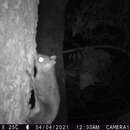tr
kırıntılardaki isimler


Dwarf scaly-tailed squirrels are social and are likely to employ some forms of communication. Little is known about social communication in this species, but it is likely to include chemical cues, sounds, touch, and visual cues.
Communication Channels: visual ; tactile ; acoustic ; chemical
Perception Channels: visual ; tactile ; acoustic ; chemical
The only major threat to dwarf scaly-tailed squirrels is the extraction of wood from their habitat. According to the IUCN Red List of Threatened Species, even though this species is poorly known, the habitat within its known range is reasonably intact when compared with forested regions in West Africa. This suggests that dwarf scaly-tailed squirrels are unlikely to be experiencing population declines currently.
US Federal List: no special status
CITES: no special status
IUCN Red List of Threatened Species: least concern
There are no known adverse effects of A. pusillus on humans.
Since only a few specimens have been found, the economic importance of A. pusillus and the benefit it has for humans is poorly known.
Dwarf scaly-tailed squirrels are important members of the ecosystems in which they live.
Dwarf scaly-tailed squirrels feed primarily on bark and fruit. One particular dwarf scaly-tailed squirrel was recorded feeding exclusively on Musanga fruit.
Plant Foods: wood, bark, or stems; fruit
Primary Diet: herbivore (Frugivore , Lignivore)
Anomalurus pusillus (dwarf scaly-tailed squirrels) occurs in Central Africa from Cameroon and Gabon to west Uganda and the northwest shore of Lake Tanganyika. Dwarf scaly-tailed squirrels are also found in West Liberia on the Du River.
Biogeographic Regions: ethiopian (Native )
Dwarf scaly-tailed squirrels depend entirely on primary tropical forest in lowland areas. This species is found at elevations up to 2000 m.
Range elevation: 2000 (high) m.
Habitat Regions: tropical ; terrestrial
Terrestrial Biomes: forest
There is little available information for A. pusillus concerning their lifespan or longevity.
Although there is no mass reported for A. pusillus, it is said to be the smallest species of anomalurid.
Dwarf scaly-tailed squirrels have a head and body length ranging from 210 to 246 mm. Their tail length, which is one third the length of their body, ranges from 138 to 157 mm. Their hind feet, with a length varying from 37 to 47 mm, contain bristle hairs that are seen over the claws.
The coloration of dwarf scaly-tailed squirrels varies from a tan, light gray color to a very dark gray. The belly of this species is usually a yellowish gray color. The tail is generally a blackish brown color on the tip. The head is generally gray without a facial pattern.
The genus Anomalurus in general has a distinctive feature which is a cape-like membrane stretched between the forelimbs and the hind limbs and between the hind legs and the tail. This feature allows them to glide from branch to branch. The membrane is supported in the front by a rod of cartilage extending from the elbow joint and attaching to the ankles at the rear. The name “scaly-tailed” refers to an area of rough, overlapping scales on the underside of the tail near the base.
Range length: 210 to 246 mm.
Other Physical Features: endothermic ; homoiothermic; bilateral symmetry
Sexual Dimorphism: sexes alike
There is little available information on predation in A. pusillus. Like other anomalurids, their cryptic coloration and arboreal habits may protect them from some predation. They are likely to be preyed on by arboreal predators such as snakes, small cats, and birds of prey.
Anti-predator Adaptations: cryptic
There is no available information on the mating system of A. pusillus.
Specific reproductive information for dwarf scaly-tailed squirrels is not known, but information from related species of Anomalurus indicate that females may have 2 litters of 1 to 3 young per year.
At birth, scaly-tailed squirrels are large, well-furred, and active and their eyes are completely open.
Breeding interval: Dwarf scaly-tailed squirrels may breed twice yearly.
Breeding season: Breeding season in dwarf scaly-tailed squirrels is not known.
Range number of offspring: 1 to 3.
Key Reproductive Features: iteroparous ; gonochoric/gonochoristic/dioecious (sexes separate); sexual ; viviparous
Relatively little is known about parental investment in A. pusillus. In related species of Anomalurus, both parents bring food back to a well-hidden nest for their young until they become independent.
Parental Investment: precocial ; pre-fertilization (Provisioning, Protecting: Female); pre-hatching/birth (Provisioning: Female, Protecting: Female); pre-weaning/fledging (Provisioning: Male, Female, Protecting: Male, Female)